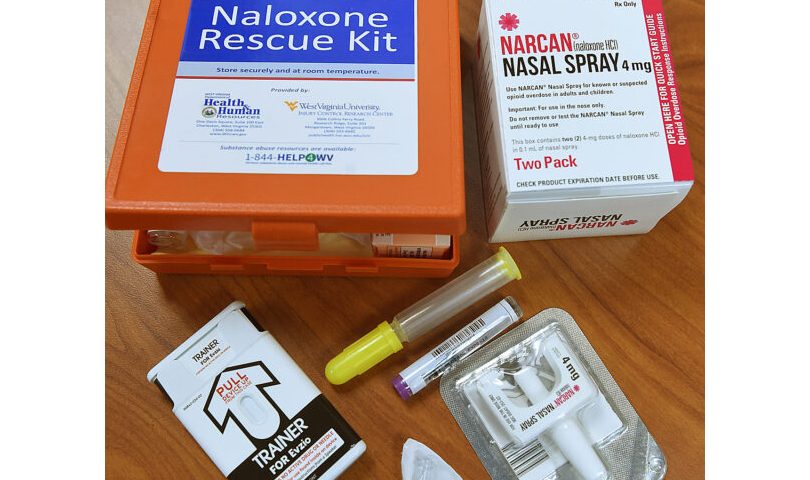MORGANTOWN – West Virginia is one of a small handful of states showing a decrease in the percentage of overdose deaths from March 2021 through March 2022. The data comes from a CDC report and was announced by the state Department of Health and Human Resources on Wednesday.
The CDC report shows two sets of data: predicted deaths and reported deaths.
DHHR cites the predicted death data in its announcement (because reported numbers can change). West Virginia’s predicted overdose death count fell by 3.63% during this period, from 1,541 predicted deaths to 1,485. Five other states also saw their predicted death counts fall: neighbors Virginia, Ohio, Pennsylvania and Maryland, and Nebraska.
Only Virginia fared better in this data set, seeing its predicted death count fall by 6.69%.
All other states saw their numbers rise, and the nationwide predicted overdose count rose by 9.7%.
In the numbers of reported deaths, West Virginia was one of seven states to see improvement, with New York joining the other six. Again, West Virginia ranked second-best after Virginia.
West Virginia’s reported deaths during the time period fell from 1,506 in March 2021 to 1,403 in March 2022, a 6.84% improvement. Virginia’s figure improved by 19.43%. Nationwide, reported deaths rose by 6.6%.
CDC explains that numbers are provisional. Predicted provisional counts represent estimates of the number of deaths adjusted for incomplete reporting. Reported provisional counts are the number of deaths received and processed for the 12-month period. Drug overdose deaths are often initially reported with no cause of death because they require lengthy investigation.
“West Virginia is starting to plateau and likely seeing a slight downward trend,” said Dr. Matthew Christiansen, director of DHHR’s Office of Drug Control Policy (ODCP). “We are encouraged by CDC’s data and will continue our efforts to end West Virginia’s substance use epidemic.”
Christiansen said that the state, under the governor’s direction, undertook a number of measures to address the overdose epidemic.
They were: With funding from DHHR’s Bureau for Behavioral Health, DHHR distributed naloxone to high-risk individuals, continued the expansion of treatment and recovery services, built a network of ODCP Regional Coordinators in the hardest hit counties, launched new stigma campaigns, worked with colleagues in law enforcement to build new Law Enforcement Assisted Diversion programs, and continued to move the treatment system towards quality outcomes.
The Dominion Post reached out to local health leaders for comment on the improved figures.
Dr. Christopher Edwards, Emergency Department medical director of Mon Health System, said, “It is great to see such improvements throughout the state to address the substance use epidemic. At Mon Health System, we hope to continue combating these issues through our Peer Recovery Programs that help to find placement for treatments for patients, events such as Save a Life Day that distributes free Narcan, and more. Our collaborations with behavioral health and addiction services across our region make a huge difference in care coordination for those in need.”
Dr. James Berry, chair of WVU’s Department of Behavioral Medicine and Psychiatry, and director of addiction services at the WVU Rockefeller Neuroscience Institute, also was pleased.
He said, “This is encouraging data and should provide addiction treatment providers, recovery advocates, first responders and state leaders some degree of consolation that their tireless efforts to save lives are making a difference. Of course, there is so much work left to do and our ultimate goal is zero overdose deaths. Absolutely no one in West Virginia should die of an overdose, which is an entirely preventable death.
“We should be laser focused in our efforts to direct evidence-based solutions to our communities at risk,” he said, “and consider well-informed polices to keep the momentum going in the right direction. We are very fortunate in this state to have many champions working together to make this happen and I am glad that they can see some good news.”
Monongalia County Health Department is holding a Free Naloxone Day from 11 a.m.-6 p.m., Thursday, Sept. 8.
Statewide, DHHR provides HELP4WV, which offers 24/7 confidential support and resource referrals through call, text, and chat lines. HELP4WV also offers a Children’s Crisis and Referral line. Residents may call HELP4WV at 844-HELP4WV, text at 844-435-7498, or chat at help4wv.com.
HELP304 offers social and emotional counseling through its professional crisis counselors. People may contact Help304 at 1-877-HELP304, text at 1-877-435-7304, or chat at http://help304.com. The Suicide & Crisis Lifeline (988) provides 24/7 free and confidential support, prevention, and crisis resources.
Tweet David Beard @dbeardtdp Email dbeard@dominionpost.com




